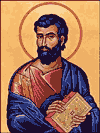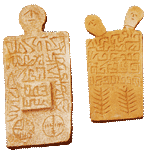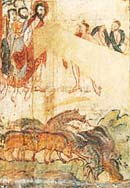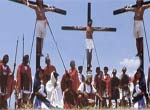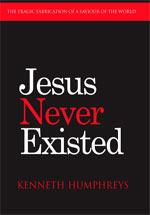He who has ears
Let him hear!
5-minute enlightenment
for those in a hurry.Extract from a public talk.
Mark (or is it Matthew? Luke perhaps?...)
In the illiterate world of Christendom depictions of Biblical characters were standardised – Paul, balding with a hooked nose, Peter with grey curly hair and a beard, etc. – so that the faithful could immediately recognize them.
And Jesus? The face of the superhero himself was modelled on that of Zeus, whose statue stood for centuries in Constantinople
Papyrus P45, f. 6 – Chester Beatty collection.
Earliest fragment of the Mark (part of chapter 7), dated to around AD 250.
Keeping the Good News Quiet!
"Jesus and his disciples went on to the villages around Caesarea Philippi. On the way he asked them, 'Who do people say I am?' ... Jesus warned them not to tell anyone about him."Mark 8.27,30
"Once when Jesus was praying in private and his disciples were with him, he asked them,'Who do the crowds say I am?' ... Jesus strictly warned them not to tell this to anyone."Luke 9.18,21
"When Jesus came to the region of Caesarea Philippi, he asked his disciples, 'Who do people say the Son of Man is?' ... Then he warned his disciples not to tell anyone that he was the Christ."Matthew 16.13,20
No Scrap
"The world has been for a long time engaged in writing lives of Jesus …
But when we come to examine them, one startling fact confronts us: all of these books relate to a personage concerning whom there does not exist a single scrap of contemporary information – not one!
… In the Augustan age historians flourished; poets, orators, critics and travelers abounded. Yet not one mentions the name of Jesus Christ, much less any incident in his life."
Moncure D. Conway (Modern Thought)
Gnostic writings on stone stele
Author?
120-140 is the most likely time for the writing of Mark's gospel – by Cerinthius.
The Cerinthians were a group founded in the 140s who used Mark's gospel exclusively.
Another possibility is that 'Markos' is a an allusion or tribute to Marcion, the shipping magnate from Pontus who in the first half of the 2nd century led the Pauline faction.
1st or 2nd century dating?
Markan phrases such as "wars and rumours of wars", "earthquakes and famines", have given rise to much speculation.
The Jewish War, though failing to presage an immediate end-time, was nonetheless interpreted by early Christians as evidence of the "birth pangs" of the end-time.
Mark's vision of Pharisees wandering around Galilee might suggest a composition before the term Pharisee fell into disuse – unless, that is, the author was consciously setting the scene with this time marker.
In any event, Mark has to predate Matthew, and Matthew appears to be have known to Polycarp in the mid-2nd century.
Matthew and Luke were clearly intended to replace the original gospel of Mark but that hope failed. Thus, to minimize the number of embarrassing contradictions between the original and later stories, a number of minor harmonizing changes were made to Mark's text, such as the insertion of the word "Nazareth" in Mark 1.9.
Nazareth was not in Mark when Matthew copied the passage into his own gospel at 3.13!
Bad Day for Pork
2000 Gadarene swine go over a cliff. Local sausage industry collapses. Thanks, Jesus.
"And forthwith Jesus gave them leave. And the unclean spirits went out, and entered into the swine: and the herd ran violently down a steep place into the sea, (they were about two thousand); and were choked in the sea."– Mark 5:13
A Play
"The Easter narrative both in its pre-Markan oral form and in the gospel version, is a legend, a religious play, and therefore could be mistaken for a piece of history ...
The 'angel' who appears at the tomb is, in fact, an actor who recites dramatic lines that were created for him, first by the early Jerusalem community (in Aramaic) and then by the evangelist Mark (in Greek)."
– Sheehan, The First Coming, p157.
Josephus, witness to 3 friends being crucified. One was taken down – and survived.
|
Though for much of Christian history the gospel of Matthew has been given primacy that honour actually belongs to the gospel of Mark, the shortest and least sophisticated of the Jesus stories. Mark's literary creation was the starting point for both Matthew and Luke. Of approximately eleven thousand words found in Mark, ninety-five per cent of those words – entire paragraphs and stories in fact – are reused in the gospel of Matthew and sixty-five per cent of them in the gospel of Luke. Contrariwise, where Matthew and Luke differ most from each other – in the nativity and resurrection episodes – it is in material not found and not copied from Mark. Thus, to understand the trajectory by which the Jesus tale developed from an original hero – a righteous man infused by God's holy spirit– through a hybrid godman possessing powers, to find final form as God incarnate on earth, one is best advised to begin with Mark's pithy masterpiece.
From Future to Past, from Sky to Earth Between the era of the Maccabees and Bar Kochba's war (approximately 160 BC to 135 AD) the increasingly radicalised factions of the Jews were animated by an expected warrior/priest (or perhaps a warrior and a priest) who would lead the 'nation of Israel' in triumph. The expectation was thus of someone in the (imminent) future, no doubt of 'Davidic' or even 'divine' lineage but otherwise, human. This monumental hope/expectation was equalled only by the monstrous calamities of 69-73, 114-117 and 132-135. Respectively, these three conflicts:
With the ultimate disaster of 135, for many unhappy Jews the theology of a 'national salvation' (or none at all) no longer gave hope. As Josephus said, God was now with the Romans. Josephus remained a Jew but reasoned the caesars were god's instrument of retribution. No doubt many despondent Jews apostatised and adopted one or other of the pagan faiths. At this low point, the need was thus created for a radical revision of the Jewish faith. The nation of Israel might perish but surely a 'way' could be found for the pious to save themselves? The answer was a new covenant between the individual and his god, for a path to a personal salvation –similar to that on offer from the pagan mysteries.
What Now? As the dispersed and desperate bands of Jews struggled with the problem, they must surely have asked, 'How had (Jewish) scripture failed them so badly?' Rather than doubt the veracity of their 'ancient oracles', priests, safeguarding their future role, deliberated and reached the conclusion that the fault was not in the texts but in the Jews themselves. On cue, as foretold, the Messiah had arrived! – but the Jewish nation – the Jews collectively – had failed to recognize him!! Even his hand-picked disciples had proved to be dullards, repeatedly failing to understand the divine message or carry forward the messianic legacy. As a result the ferocious god Yahweh had punished the Jews even more mercilessly than he had punished them in the past. The disaster now made perfect sense. And hope could return. If the righteous individual were to worship this erstwhile messiah, that individual, at least, could be assured of a place in the 'new Israel'. Having decided on the theology, the questions naturally arose, 'Who had been the lost Messiah?' and 'Why had he not been recognised?' Here, new meanings teased out of old scripture (in good 'midrash' tradition) provided the answer: he would have been in disguise; he would have concealed his messiahship. The new theology needed to be woven into a convincing story, one that could be read aloud to groups of dispirited Jews. From the moment the proto-Christian priests adopted the conviction that a messiah had been and gone, the hunt was on to identify the missed saviour. Temple records and much else had been lost in the wars (some, of course, secreted away in jars at Qumran to be discovered twenty centuries later) but fragments, half-remembered stories and the rich corpus of pagan mythology would provide the missing detail. If the letters of Rabbi Saul (aka Paul) were available to them at all, they contributed only the popular gnostic idea that the 'risen Christ' reigned in heaven and was a wholly spiritual agency, who would descend on a cloud at the End Time. For the proto-Christians this arrival would be a second coming; they were about to fabricate the first.
The Lost Messiah In resolving the theological conundrum that 'the messiah had been but had gone unrecognised' Mark has to have his hero perform endless miracles but then command the persons healed, onlookers, disciples, and even demons to silence (1.34; 1.44; 3.12; 5.43; 7.36; 8.26; 8.30; 9.9). The entity that brings the Word tells them all to keep quiet about it! Of course, this introduces an inconsistency – whole towns witness his deeds! – but then inconsistency permeates the entire bible. Mark's short story is one of suffering (and the Jews were suffering), leading to a place in the soon to arrive 'Kingdom of God ' for believers. Mark begins building his Jesus based upon the 'suffering servant' of Isaiah.
But in this first of the gospels, there is no genealogy; there is no star, no nativity pageant, no Bethlehem. Mary is mentioned by name once only (probably a later interpolation) and Joseph not at all. Jesus actually disowns his family (3.31,35); they in turn think he's gone mad (3.21). This can hardly be the Mary visited by an archangel, who 'rejoices' in the 'great things done to her' when she receives her divine pregnancy! There is no flight to Egypt, nor murder of babies, no 12-year-old in the Temple. None of this has yet been written.
Nor has Mark's Jesus yet become the perfect being of the later gospels. His hero is a 'Son of God' but nonetheless one with human characteristics. His Jesus appears sorrowful (14:34), disappointed (8:12), displeased (10:14), angry (11:15–17), amazed (6:6), and fatigued (4:38). In Nazareth, he was unable to do 'powerful work' because he was not believed in. 'Like a dove' the holy spirit had descended on him at baptism; presumably before this he had been a mere mortal. The first half of Mark (chapters 1 - 9) is a catalogue of miracles and exorcisms, quite a lot of it repetitive (he uses the word 'immediately' more than 40 times!), plus a whole bunch of parables, which serve only to baffle his followers. Taking a more theatrical turn, Mark has his Jesus 'transfigure' into a glowing figure on a convenient mountain top where he is addressed by a speaking cloud confirming him as Son of God. Thereafter, Jesus resumes the role of perambulating exorcist on the road to Jerusalem. There follows a curious chapter of 'End Time' prophecy (chapter 13): Why the prophecy at all? It was widely known that Jesus ben Anania, in 62 AD, had made such a ‘correct’ prophecy (as recorded by Josephus in 79 AD). Mark wanted his hero to have no less a gift of prophecy, so he took the most well-known example of a 'successful' prophecy of the time and re-worked it.
The End Time Postponed The world went on, despite the fall of the Temple, so Mark has Jesus say ‘the end shall not be yet.’ (13.7). Mark is discounting any idea that the destruction of the first Jewish war would have signalled the ‘end time’ – indicative that he was writing long after conflict of 66-70 AD. Famously, the godman says ‘you shall hear of wars and rumours of wars’, which nicely covers all the subsequent rebellions of the early decades of the second century. All this ‘prophecy’ of the so-called ‘little Apocalypse’ of Mark 13 actually fits much better a later date. The clues are there: 1. ‘false' Christs:
The internal dating evidence for Mark comes from the fact that Mark has his Jesus ‘prophesy’ the destruction of the Temple in 70 AD. Mark makes it the last public discourse of Jesus before his arrest:
In the 90s the Jews first introduced a curse upon ‘apostates’ and Jewish hostility to the Jewish/Christian heretics was greatest between 100 - 120 AD. The second Jewish war, unfortunately, did not have its Josephus to record the events but it was, in fact, a larger conflict. It had the more profound consequence of wiping Judaea off the map.
The little aside that Mark adds 'Let the reader understand' seems to indicate that he knows calling the temple of Jupiter 'an abomination' could be regarded as seditious, and Hadrian came down hard on the Jews after the war of 135 AD. If Mark were just referring to the desolation caused by the first war, the aside does not make sense. Even the Romans, at least according to Josephus, were sorry about the destruction of the Temple. One should also note that the reference to 'flight in winter' had specific meaning for the events of the second Jewish war. It was in winter that the Roman armies partially withdrew to regroup, making a flight possible. Nothing like this happened in winter time during the first war. Thus we can piece together the sequence of events: In the aftermath of the first Jewish War (66-73) remnants of the Essenes, began calling themselves the 'Church of God'. Their now dead Teacher of Righteousness assumed retrospectively the mantle of the Messiah. Challenged as they were by Gnostics (proponents of an entirely divine Christ) and in a desperate attempt to renew and widen their membership, they embarked on the process of romanticising the life of the half-forgotten hero. The process of 'creative biography' was not lost on the Paulites, working the ghettoes of the Greek cities. From the onset of the war, refugees from Palestine had flooded into the city of Alexandria, taking their cults with them. Partisans of Paul’s ‘celestial superman’, agitating for support in the crowded Jewish settlements, faced their main challenge not from Gnostics or Essene survivors but from the baptisers – both followers of John the Baptist and the sun-worshipping Therapeutae. Like the Paulites, the baptism factions had escaped the carnage of the war by refusing to be drawn into a fight with the Romans. The followers of John, with a real dead hero and martyr, presented the greater challenge.
Creative Biography The death of Paul – or whoever the New Testament character "Paul" was based upon – left a void in the leadership of the 'gentile faction' within the proto-Christian movement. To preserve and defend themselves they wrote a story of a 'Jesus' character, inspired partly by the life and teachings of Paul himself. In what proved to be the most profound act of religious synthesis Paul’s Judaised pagan sun-god was given human form and placed in a recent past. To win over the Baptists, a clever story was woven. Firstly, the baptist’s importance was acknowledged but John is conveniently quoted as saying that ‘one greater than he’ will follow (Mark 1.7). A less than celestial Jesus is then conjectured and given a connection to the baptist – Jesus, it would seem, like any other follower, had gone to John to be baptised! The ‘theology’ here is very weak – why would the superior and sinless Jesus have need of a baptism of repentance from the inferior, ‘born with sin,’ John? Apparently, at this point the Holy Spirit had worked its magic and had enlightened Jesus as to his mission (‘and the Spirit like a dove descending upon him’) (Mark 1.10) – and this, for the same Pauline Christ that had existed ‘since the world began’ and presumably knew a thing or two! Nonetheless, the superiority of Jesus over John the Baptist was demonstrated by the tale. John’s story was then closed off by his arrest (‘Now after that John was put in prison…’ (Mark 1.14). In less than three hundred words, the baptist was disposed of! With John safely out the way, Jesus began his own ‘ministry,’ coming out of the shadows (or rather, the ether) and taking on a public role (in a Palestine, a half century earlier). The fictitious life of Jesus has been overlaid on the real life of John. The divine ‘eagle’ had landed. Within a few years the legend – that a celestial Christ had actually lived on earth – had gained embellishments. John had met a pretty dramatic end by beheading; no better way to upstage that fate than a torturous crucifixion. The problem was squaring that particular claim with Jewish scripture. Followers of a Pauline faction combed through the authoritative Greek/Jewish text, the Septuagint for an answer. They already had – from pagan sources – the notion that their hero went from life to death to life again. Now they sought out each and every ‘prophecy’ that could confirm that a fallen leader could and would be the anticipated Messiah. For them the crucial text was an obscure reference in Isaiah, to a ‘suffering lamb.’
This ‘prophecy’, from the long dead sage (in reality, Isaiah is a work of many hands and reflects Jewish history of the 7th to 5th centuries) did not wash with most Jews (it was a blatant wrenching out of context). But for the partisans of Christ it was enough to ‘prove’ the messiah would indeed be a ‘sacrifice’ rather than a conqueror. The embryonic crucifixion sequence in Mark is very brief (it takes up just eight verses from a total of six hundred and sixty five!), makes no mention of Jesus’s resurrection, and ends with frightened women fleeing from an empty tomb and saying nothing! (see J. Spong, Resurrection, p 59] The Paulites could now defend the ignominy of their fallen hero’s wretched death by scripture – but they faced an uphill struggle. The later Matthew re-write will add tomb guards, cast off burial clothes and ecstatic women – it is they who have the first, uplifting encounter with the risen Christ. But for the moment, the crucifixion/resurrection is a flimsy finale to a gospel taken up more with baptism. If many Jews remained reluctant to accept that a ‘pacifist’ messiah had already lived and died it was because their vast messianic hopes in no way included a pathetic criminal, hanging limp on a cross. But for gentiles, with centuries of tradition of dying gods, the dramatic story had great appeal ... |
|||||||||||||||||||||||||||||||||||||||||||||||||||||||||||||||||
|
|||||||
Sources:
S. Angus, The Mystery Religions (Dover Books, 1975)
Timothy Freke & Peter Gandy, The Jesus Mysteries (Thorsons,
1999)
Dan Cohn-Sherbok, The Crucified Jew (Harper Collins,1992)
Robert L. Wilken, The Christians as the Romans Saw Them (Yale,
1984)
Josephus, The Jewish War (Penguin, 1959)
Leslie Houlden (Ed.), Judaism & Christianity (Routledge, 1988)
Karen Armstrong, A History of Jerusalem (Harper Collins, 1999)
Acharya S. The Christ Conspiracy (Adventures, 1999)
Michael Walsh, Roots of Christianity (Grafton, 1986)
Peter Roberts, In Search of Early Christian Unity (Vantage, 1985)
Robert L. Wilken, The Myth of Christian Beginnings (SCM Press, 1971)
Michael Turton's excellent line-by-line
Historical Commentary on the Gospel of Mark
|
||||||||||||||||||||||||||||||||||||||||
|
|
|
||
Copyright © 2004
by Kenneth Humphreys.
Copying is freely permitted, provided credit is given to the author and no material
herein is sold for profit.
